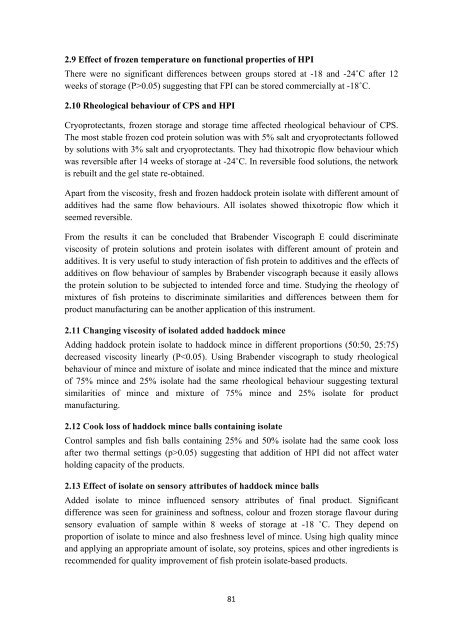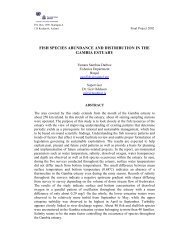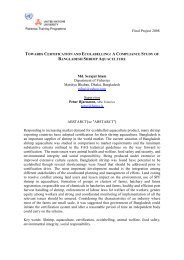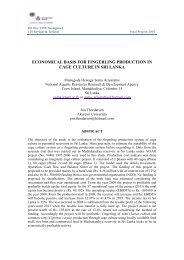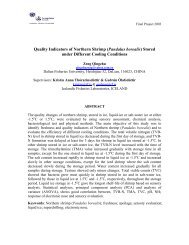Evaluation and Utilisation of Fish Protein Isolate Products
Evaluation and Utilisation of Fish Protein Isolate Products
Evaluation and Utilisation of Fish Protein Isolate Products
- No tags were found...
You also want an ePaper? Increase the reach of your titles
YUMPU automatically turns print PDFs into web optimized ePapers that Google loves.
2.9 Effect <strong>of</strong> frozen temperature on functional properties <strong>of</strong> HPIThere were no significant differences between groups stored at -18 <strong>and</strong> -24˚C after 12weeks <strong>of</strong> storage (P>0.05) suggesting that FPI can be stored commercially at -18˚C.2.10 Rheological behaviour <strong>of</strong> CPS <strong>and</strong> HPICryoprotectants, frozen storage <strong>and</strong> storage time affected rheological behaviour <strong>of</strong> CPS.The most stable frozen cod protein solution was with 5% salt <strong>and</strong> cryoprotectants followedby solutions with 3% salt <strong>and</strong> cryoprotectants. They had thixotropic flow behaviour whichwas reversible after 14 weeks <strong>of</strong> storage at -24˚C. In reversible food solutions, the networkis rebuilt <strong>and</strong> the gel state re-obtained.Apart from the viscosity, fresh <strong>and</strong> frozen haddock protein isolate with different amount <strong>of</strong>additives had the same flow behaviours. All isolates showed thixotropic flow which itseemed reversible.From the results it can be concluded that Brabender Viscograph E could discriminateviscosity <strong>of</strong> protein solutions <strong>and</strong> protein isolates with different amount <strong>of</strong> protein <strong>and</strong>additives. It is very useful to study interaction <strong>of</strong> fish protein to additives <strong>and</strong> the effects <strong>of</strong>additives on flow behaviour <strong>of</strong> samples by Brabender viscograph because it easily allowsthe protein solution to be subjected to intended force <strong>and</strong> time. Studying the rheology <strong>of</strong>mixtures <strong>of</strong> fish proteins to discriminate similarities <strong>and</strong> differences between them forproduct manufacturing can be another application <strong>of</strong> this instrument.2.11 Changing viscosity <strong>of</strong> isolated added haddock minceAdding haddock protein isolate to haddock mince in different proportions (50:50, 25:75)decreased viscosity linearly (P0.05) suggesting that addition <strong>of</strong> HPI did not affect waterholding capacity <strong>of</strong> the products.2.13 Effect <strong>of</strong> isolate on sensory attributes <strong>of</strong> haddock mince ballsAdded isolate to mince influenced sensory attributes <strong>of</strong> final product. Significantdifference was seen for graininess <strong>and</strong> s<strong>of</strong>tness, colour <strong>and</strong> frozen storage flavour duringsensory evaluation <strong>of</strong> sample within 8 weeks <strong>of</strong> storage at -18 ˚C. They depend onproportion <strong>of</strong> isolate to mince <strong>and</strong> also freshness level <strong>of</strong> mince. Using high quality mince<strong>and</strong> applying an appropriate amount <strong>of</strong> isolate, soy proteins, spices <strong>and</strong> other ingredients isrecommended for quality improvement <strong>of</strong> fish protein isolate-based products.81


